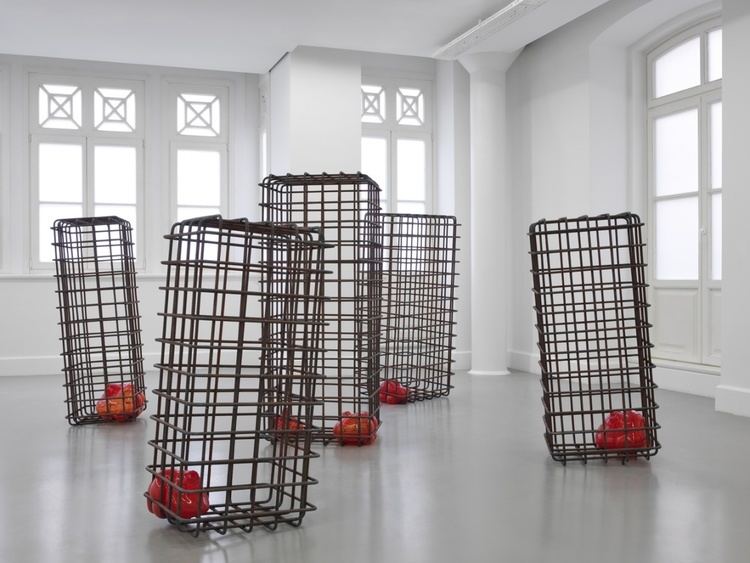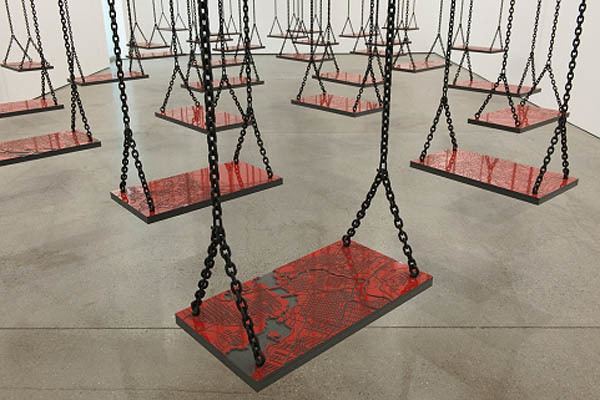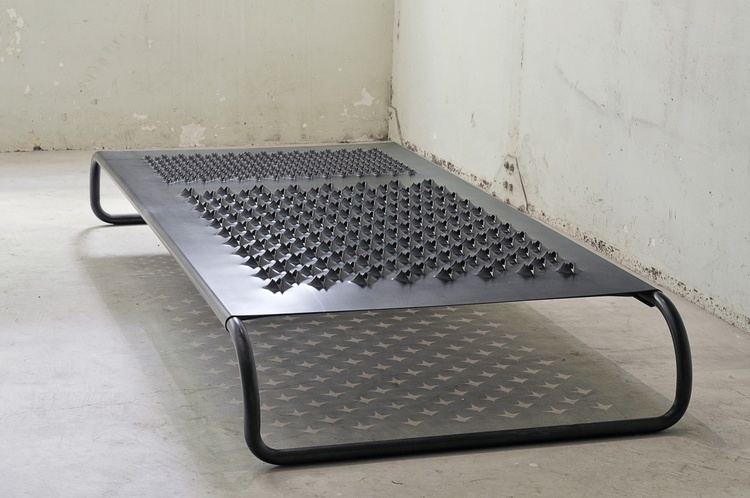Name Mona Hatoum Nominations Turner Prize Movies Measures of Distance | Period Contemporary art Role Artist | |
 | ||
Education Lebanese American University, Central Saint Martins, Slade School of Fine Art | ||
Artist interview mona hatoum kochi muziris biennale 2014
Mona Hatoum (Arabic: منى حاطوم born 1952), is a Lebanese-born Palestinian video artist and installation artist who lives in London, United Kingdom.
Contents
- Artist interview mona hatoum kochi muziris biennale 2014
- Mona hatoum installation aspinwall house kochi muziris biennale 2014
- Biography
- Artworks
- Early work
- Measures of Distance
- Later work
- The Body
- Politics
- Exhibitions
- Public collections
- Awards
- References

Mona hatoum installation aspinwall house kochi muziris biennale 2014
Biography

Mona Hatoum was born in 1952 in Beirut, Lebanon to Palestinian parents. Although born in Lebanon, Hatoum does not identify as Lebanese. As she grew up, her family did not support her desire to pursue art. She continued to draw throughout her childhood, though, illustrating her work from poetry or science class. Hatoum studied graphic design at Beirut University College in Lebanon for two years and then began working at an advertising agency. Hatoum was displeased with the work she produced while working in advertising. During a visit to London in 1975, civil war broke out in Lebanon and Hatoum was forced into exile. She stayed in London, training at both the Byam Shaw School of Art and the Slade School of Fine Art (University College, London) between the years 1975 and 1981.
Artworks

Hatoum explores a variety of different subject matter via different theoretical frameworks. Her work can be interpreted as a description of the body, as a commentary on politics, and on gender and difference as she explores the dangers and confines of the domestic world. Her work can also be interpreted through the concept of space as her sculpture and installation work depend on the viewer to inhabit the surrounding space to complete the effect. There are always multiple readings to her work. The physical responses that Hatoum desired in order to provoke psychological and emotional responses ensures unique and individual reactions from different viewers.
Early work

Hatoum's early work consisted largely of performance pieces that used a direct physical confrontation with an audience to make a political point. She used this technique as a means of making a direct statement using her own body; the performances often referenced her background and the political situation in Palestine. In her work, she addressed the vulnerability of the individual in relation to the violence inherent in institutional power structures. Her primary point of reference was the human body, sometimes using her own body.

One of her first major pieces, Measures of Distance, explores the themes topics of her early art.
"Measures of Distance"
Created in 1988, "Measures of Distance" illustrates Hatoum's early themes of family, displacement, and female sexuality. The video piece itself is fifteen minutes long and consists of intimate, colored photographs of Hatoum's mother showering. Hatoum overlays the photographs with letters from her mother to Hatoum. The letters are handwritten in Arabic and compose the themes and the narration of the video that Hatoum is trying to convey. Hatoum's mother, living in Beirut, wrote the letters to Hatoum, living in London, and speaks of the difficulty of sending letters in a time of conflict in Lebanon. Hatoum herself reads the letters aloud in both Arabic and English. The video roots itself in the brief family reunion that occurred in Beirut between Hatoum and her parents in 1981. While primarily about the mother-daughter relationship, in her mother's letters Hatoum's father is mentioned and thus the father-daughter relationship as well as the husband-wife relationship is examined in this video.
The elements of the video—the letters, Hatoum's mother's wish to see her, and mentions of the war by Hatoum's mother—explore how the war in Palestine and the war in Lebanon displaced the identity and the relationships of Hatoum and her family. The video is neither a documentary nor meant to be journalistic. The video makes critiques about stereotypes while remaining optimistic, since the narration speaks positively in most of the letters except when speaking about the distance between the mother and daughter. Hatoum attempts to recreate the moment she had with her mother when they reunited in Beirut; the moment when Hatoum asked to photograph her in the shower. Instead of showing direct scenes about the Palestinian-Israeli Conflict or the Lebanese civil war, Hatoum shows the dire effects both wars have had on her family relationships and her identity. Displaying cultural and familial displacement, Hatoum distances and draws Western audiences closer through her English and Arabic narration.
What is especially unique about this video is how it is a portrait of a Palestinian woman. Hatoum gives her mother a voice in the video art that otherwise would not have been heard by Western audiences, Arabic and non-Arabic. The video attempts to contradict stereotypes typically made specifically about Arabic women. The Tate Modern describes the portrait in the following words: "It is through the daughter's art-making project that the mother is able to present herself freely, in a form which cements a bond of identity independent of colonial and patriarchal concerns." "Measures of Distance" is one of the few works done by Hatoum that speaks directly to her background. In other works, Hatoum prefers to be more abstract and to leave the work open ended. While not as abstract as many of her other works, the viewer is still forced to work through how to understand the formal elements of the video. They are not easily given by Hatoum like her narration is. "The video transmits the 'paradoxical state of geographical distance and emotional closeness.'"
The video was screened at the London Film Festival, AFI National Video Festival, and the Montreal Women's Film and Video Festival.
Later work
In the late eighties, Hatoum abandoned performances as politically too direct and turned her attention instead to installations and objects, taking up some of the earlier ideas from her student days at the Slade School of Art in London. From then on, she relied on the kind of interactivity that lets the spectator become involved in the aesthetic experience without the presence of the artist herself as performer making her the focus of attention.
Her work from the 1990s onwards made the shift from making statements to asking questions. Much more is required of the viewer as performances were replaced by sculptures and installations that required a level of mental and physical interactivity with the viewer. Her practice has shifted towards site specificity in her Institute of Contemporary Art, Boston and Kunsthalle Hamburg.
The Body
Many of Hatoum's early pieces situate the body as the locus of a network of concerns—political, feminist, and linguistic—thereby eliciting a highly visceral response.
Politics
The political possibilities for the uncanny visual motif are relevant to discussions of Hatoum's work, as the disruption achieved at a psychological level can have broad implications involving power, politics, or individual concerns. The allusiveness attained by her work is not always referencing grand political events, or appealing to a generalized cultural consciousness, but instead to a seemingly unattainable threat that is only possible to address on an individual scale.
However, Hatoum is aware of her work and it having political links to other political groups, especially in regards to black struggle. In an interview with Michael Archer, Hatoum asserts:
"At the beginning it was important to think about the black struggle as a total political struggle. There are common political forces and attitudes that discriminate against people. In the same way as feminism started off with this totalizing concept of 'sisterhood', and then we ended up with many feminisms, if you like. The black struggle became more diversified once the basic issues were established. And blackness here is not to do with the colour of your skin but a political stance." - Mona Hatoum, 1997.
Exhibitions
Since 1983, Mona Hatoum has been displaying both her installations and her video performance art pieces in exhibitions around the world. She has been featured in individual exhibitions as recently as 2011 at White Cube in London.
Some of her other solo exhibitions of note include: Centre Pompidou, Paris (1994), Museum of Contemporary Art, Chicago (1997), The New Museum of Contemporary Art, New York (1998), Castello di Rivoli, Turin (1999), Tate Britain, London (2000), Hamburger Kunsthalle, Kunstmuseum Bonn, Magasin 3, Stockholm (2004) and Museum of Contemporary Art, Sydney (2005), Parasol Unit, London (2008), Darat Al Funun, Jordan (2008), Fondazione Querini Stampalia, Venice (2009) and Beirut Art Center (2010).
She has also participated in a number of recognized group exhibitions, including: The Turner Prize (1995), Venice Biennale (1995 and 2005), Biennale of Sydney (2006) and the Biennale of Montreal; Drone the automated image (2013). A solo exhibition entitled "Turbulence" is organised in 2014 by Mathaf Arab Museum of Modern Art in Doha.
Hatoum's work was featured in a solo exhibition at the Institute of Contemporary Art, Boston in 2015.
In May 2016, Tate Modern held a "comprehensive exploration into 35 years of Hatoum's work in Britain, from her early performance and video works to her sculpture and large-scale installation"
